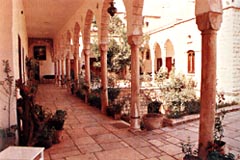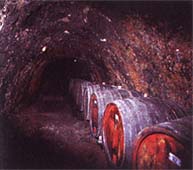Zahle
Profile Altitude:
1010m
Distance from Beirut: 52km
Getting there
From Beirut, take the Damascus road which passes through Bhamdoun, Sofar,
Mdeirej, and Chtoura and then to Zahle. It is about one and a half hours from
Beirut. |
 |
Zahle
A red-roofed town set among
the eastern foothills of Mount Sannine, Zahle enjoys a prime location in the
Beqaa valley. Snowcapped mountains tower above it in winter, while in summer its
945 meter elevation keeps the air light and dry.
The city center spreads
along both banks of the Berdawni River, with the older section of the upper
elevations of the west bank. At the northern end of town is the Bardouni river
valley known as Wadi el-Aarayesh (Grape Vine Valley) - the site of Zahle’s
famous outdoor restaurants.
Zahle styles itself “The
city of Wine and poetry”, and with good reason. In this century alone some 50
poets and writers were born here and almost as many excellent wines and araks
have been produced in the area.
The romance of wine and
poetry is balanced by Zahle’s more business like position as the administrative
and commercial capital of the Beqaa valley (42.27% of Lebanon’s territory) as
well as its rank as the country’s third largest city (population 150,000). Zahle
is also an agricultural town which produces vegetables, fruit, grains and most
importantly, grapes.
 |
|
Tucked
away from Lebanon’s busy coastal centers, the people of Zahle have developed
their own brand of individualism and way of doing things. Even their spoken
Arabic has a particular flair. The city’s reputation for intellectual vigor
comes from a long line of writers, thinkers and poets who have contributed
to Lebanon’s cultural and political scene. |
Zahle in
History
Zahle was founded about 300
years ago in an area whose past reaches back some five millennia. In the early
18th century the new town was divided into three separate quarters, each of
which had its own governor.
The city
enjoyed a brief period as the region’s first independent state in the 19th
century when it had its own flag and anthem.
Zahle was
burned in 1777 and 1791, and it was burned and plundered in 1860. But during the
rule of the Mutasarrifiah, Zahle began to regain its prosperity. The railroad
line which came through in 1885 improved commerce and town became the internal
“port” of the Beqaa and Syria. It was also the center of agriculture and trade
between Beirut and Damascus, Mosul, and Baghdad.
Considered the
birthplace of the Lebanese army, Zahle has played a major role in the political
life of the country.
Zahle Berdawni Restaurants
The
Bardouni is a river that flows out of Mt. Sannine and down through Zahle. It
is also a name synonymous with Lebanon’s famous mezze and the delights of
outdoor dining.
The
Bardouni restaurant tradition began over a hundred years ago with a few simple
riverside cafes. Today it is a virtual bazaar of tree-shaded eating places known
as “casinos”, every one more inviting than the next. Not surprisingly,
competition is fierce, so each establishment outdoes itself with fountains,
pools, and cooling shade to tempt potential customers.
Here you
can enjoy the traditional Lebanese mezze as it is served nowhere else. To add to
the sense of timelessness, delicious mountain bread is baked before your eyes
and a man in baggy trousers and fez is on hand to pour Lebanese coffee. He can
also provide diners with a hubble-bubble (water pipe).
On the
cliffs above the Bardouni are the restaurants of Kaa el Reem, also known for
their excellent food and atmosphere.
Wine And Arak
Zahle’s
association with the grape is pervasive, for it lies at the heart of an area
that has been making wine since early antiquity. At the city’s southern
entrance the statue of a graceful female personifies wine and poetry, but you
don’t have to look far to see evidence of the real thing. The hills north of
town with names like Wadi Hadi, Harqat, Bir Ghazour and Tell Zeina are covered
with the neat rows of vineyards that supply Zahle’s wine and arak industries.
 |
|
Many of the
wines have been formally recognized abroad for their fine quality - equal to
some of the best in Europe.
A tour of
Zahle’s Ksara winery is a good way to see how wine and arak are made. Of special
interest here are the extensive underground caves built around a natural grotto
known and enlarged by the Romans. |
Local Celebrations
Each year between the
10th and 20th of September Zahle mounts its week-long
Festival of the Vine, a celebration shared with the city’s Flower Festival. In a
carnival-like atmosphere “Miss Vine” is elected and cars are decorated with
flowers representing national symbols.
Zahle is almost famous
for its Corpus-Christi festival which dates back to 1825 when the town was
spared the ravages of a contagious disease. Corpus-Christi is celebrated on the
first Thursday of June with a torch-light parade held on the eve of the
festival. The next morning a mass takes place at Our Lady of Najat Church,
followed by a procession of townspeople carrying the “Holy Bread” through the
streets.
What to See in Zahle
A good example of Zahle’s
local architecture is the restored Geha House in the old part of town. Also this
is a private home, one can easily appreciate its courtyard, garden and arched
upper galleries - all typical of 17th century architecture. An old underground
tunnel 1,400 meters long leads from the house to the church of St. Elias (Al-Tuwak).
Built by Sheikh Khalil Geha
in the early 17th century, today the seventh generation of the Geha family
resides in this 24-room dwelling.
Other private residences in
the same area are the lovely al-Hindi, Youssef Azar and Wadih Skaf houses. These
are several hundred years old and also designed with arcades and walled gardens.
The restored Serail or
government house in the old part of town dates from 1885. This beautiful
building, whose architecture reflects the European and Arab influences of The
Ottoman period, will soon house the offices of the municipality and a museum
illustrating Zahle’s history.
At the start of the 20th
century Zahle began building hotels to serve its budding tourist and summer
resort trade. Although the “Sohat” (health) Hotel built in 1878 has been
demolished, three establishments from this era can still be seen: the Hotel
America, the Hotel Akl and the Hotel Kadri.
The Kadri, built in 1906,
has seen its share of history. The hotel was taken over by the Turkish army in
1914 and used as headquarters and a hospital during World War I. It was from the
Kadri as well that in 1920 the French Mandate authorities announced annexation
of the judiciary areas which would give “Greater Lebanon” its present-day
borders.
The Souk al-Blatt or “tiled
market” is a market street leading to one of the oldest part of the city. A
large part of Zahle’s history was written in this Souk, where in former times
travelers to and from Syria, Baghdad and Palestine bought and sold their goods.
A project is planned to restore the street and make it a center for crafts and
other traditional activities.
Houch El-Zarani is located near
the post office on the east side of the river. In past centuries this housh, or
market area, was a conglomerate of khans (caranvansaries), craft centers and
shops. Here shoemakers, woodworkers, weavers, copper workers and saddle makers
plied their trades. It was also an important commercial center where vendors
sold agricultural and industrial products.
Many of the old buildings,
embellished by carved ceilings, vaulted interiors and decorated faÇades, still
stand. Today these structures are somewhat obscured by modern shopfronts, but
projects are afoot to restore the area. In the meantime you can still discover a
taste of old Zahle here.
Sayedit Zalzaly is Zahle’s oldest
church. Built in 1700, it originally stood at the center of the city.
The Church of St. Elias is the
second church built in Zahle (1720). This impressive structure is also known as
Al-Moukhallasiah.
The Monastery of Our Lady of
Najat (1720) has the largest bell tower in Lebanon. The monastery is known as
well for a beautiful icon of the Virgin Mary, a gift from the King of Prussia.
The Monastery of Saint
Elias at-Tuwak, which dates to 1755, was renovated in 1880 after a fire. Today
it remains one of Zahle’s most venerable monuments.
The landmark Tell Shiha
Hospital, with its red tile roof, was opened in 1948. Located a high on a high
hill of the same name, this site is a good spot for photographs.
For the most spectacular
view, go to the 54-meter-high hilltop tower of Our Lady of Zahle and the Beqaa
located east of town. Here an elevator takes you up to a viewing platform
overlooking the city and the extending plain. The structure is crowned with a
ten-metermhigh bronze statue of the Virgin, the work of the Italian artist,
Pierroti. The base houses a small chapel seating about 100 people.
The Zahle area has some
scattered ancient remains indicating a history going back at least to the Bronze
Age (1200-3000 BC). You can see cave tombs in the cliffs of the Wadi el-Aarayesh,
while Byzantine, Roman and Canaanite sarcophagi and ancient pottery sherds have
been found in the hills around the city.
Information From the Ministry of
Tourism

|